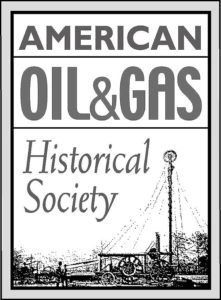by Bruce Wells | Sep 18, 2025 | Petroleum Pioneers
Pico Canyon oilfield brought pipelines, refineries, and Chevron.
Following the 1859 first commercial U.S. oil discovery in Pennsylvania, the earliest petroleum exploration companies were attracted to California’s natural oil seeps. Small but promising discoveries after the Civil War led to the state’s first gusher in 1876 — and the launching of a new California industry.
Pico Canyon, less than 35 miles north of Los Angeles, produced limited amounts of oil as early as 1855, but there was no market for the petroleum found near natural oil seeps. The first California drilling boom arrived a decade later in the northern part of the state with an oilfield also found near seeps.
Humboldt County Oil
Completed in 1865 by the Old Union Matolle Oil Company, the Humboldt County well produced oil near the aptly named Petrolia. The oilfield discovery quickly attracted some of America’s earliest exploration companies.
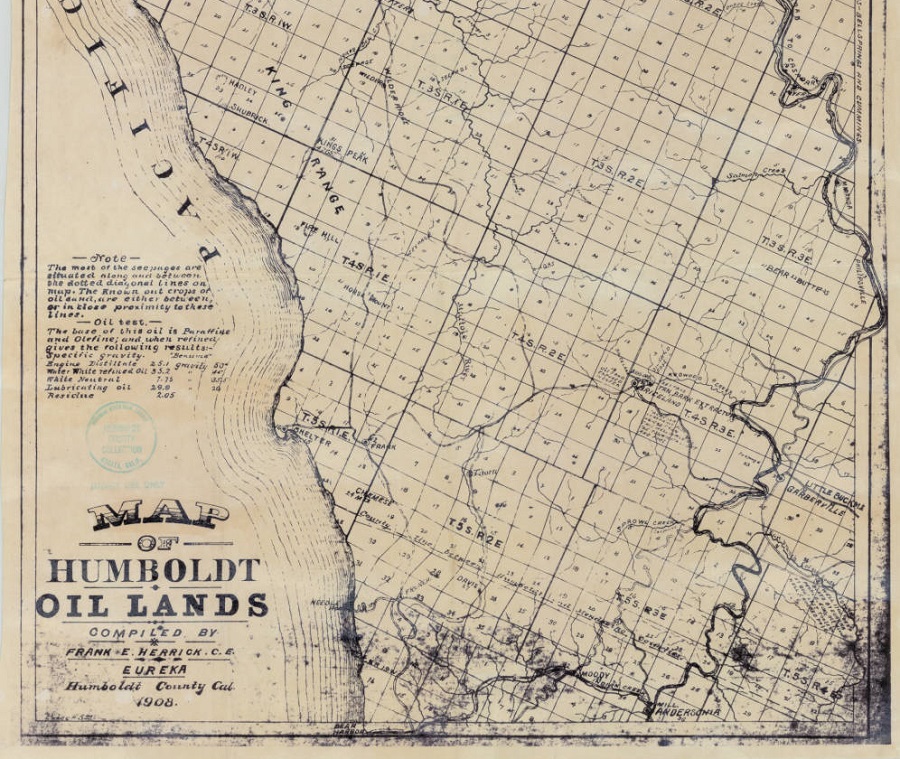
Detail of a 1908 “Map of Humboldt County Oil Lands” includes post-Civil War commercial oil wells that attracted more drilling to northern California. Map courtesy Humboldt County Map Collection, Cal Poly Humboldt Library Special Collection.
A California historical marker (no. 543) dedicated on November 10, 1955, declared:
California’s First Drilled Oil Wells — California’s first drilled oil wells producing crude to be refined and sold commercially were located on the north fork of the river approximately three miles east of here. The Old Union Mattole Oil Company made its first shipment of oil from here in June 1865 to a San Francisco refinery. Many old wellheads remain today.

Although the “Old Union well” initially yielded about 30 barrels of high-quality oil, production declined to one barrel of oil per day, and the prospect was abandoned, according to K.R. Aalto, a geologist at Humboldt State University.
The Humboldt County well in what became the oilfield “attracted interest and investment among oilmen because of the abundance of oil and gas seeps throughout that region,” Aalto noted in his 2011 article in Oil-Industry History. But the California petroleum industry truly began to the south, at Pico Canyon Oilfield, a few miles west of Newhall.
Pico Canyon Well No. 4
In Pico Canyon of the Santa Susana Mountains, Charles A. Mentry (1847-1900), who had formed a partnership establishing the California Star Oil Works Company, drilled three exploratory wells between 1875 and 1876. All showed promise, and the first West Coast oil gusher arrived with his fourth well. The oilfield discovery would lead to the creation of a major oil company.
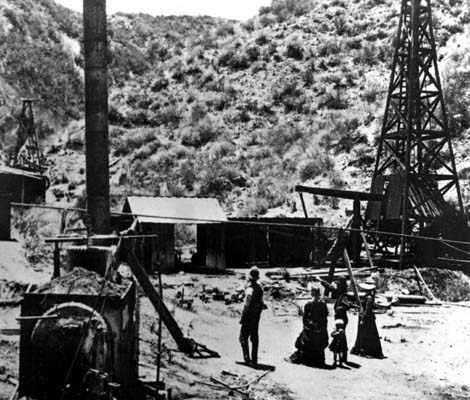
The steam boiler and cable tools, including the “walking beam,” of Pico Well No. 4 in 1877. Photo by Carleton Watkins courtesy Los Angeles Public Library Photo Collection.
Drilling with a steam-powered cable-tool rig in an area known for its many oil seeps, Mentry discovered the Pico Canyon oilfield north of Los Angeles. California’s first truly commercial oil well, the Pico Well No. 4 gusher of September 26, 1876, prompted more development, including pipeline construction and an oil refinery for producing kerosene.

According to an article in the Los Angeles Times, the well initially produced 25 barrels a day from 370 feet. Mentry improvised many of his cable tools, including making a drill stem out of old railroad car axles he welded together.
“The railroad had not then been completed, there was no road into the canyon, water was almost unattainable, and there were no adequate tools or machinery to be had,” noted the Times article.
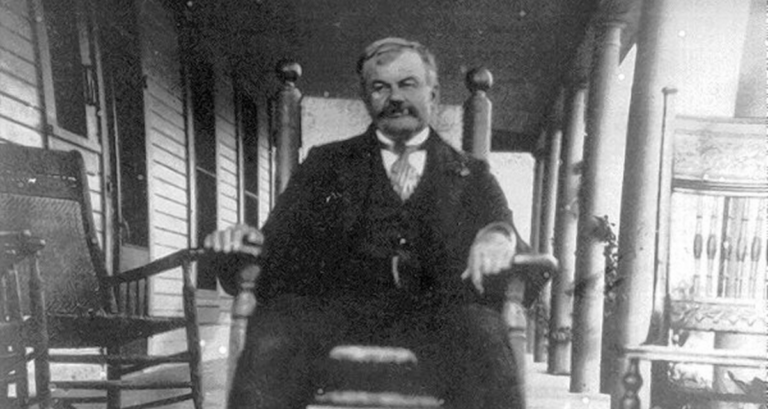
Charles Mentry had already successfully drilled 42 wells near Titusville, Pennsylvania, before exploring in the Santa Clara Valley — and launching California’s petroleum industry. Photo courtesy KHTS Radio, Santa Clara.
Mentry persevered, and his success in Pico Canyon led to the founding of “Mentryville,” the onetime drilling boom town that is today the site of Stevenson Ranch.
“Although his life was tragically cut short by illness on October 4, 1900, from typhoid fever, Mentry’s legacy as a pioneer in California’s oil industry endures,” noted KHTS Radio, Santa Clara. “His work in Pico Canyon not only made him a key figure in the region’s development but also set the stage for California’s future as an oil-rich state,” KHTS reported in 2025.
Visit the Santa Clarita Valley Historical Society website to learn more Pico Canyon petroleum exploration and production history.
First Refinery
California Star Oil Works deepened the well to 560 feet, increasing daily production by 125 barrels, and constructed its pipeline from Pico Canyon to the newly built refinery in Newhall, just south of Santa Clarita.
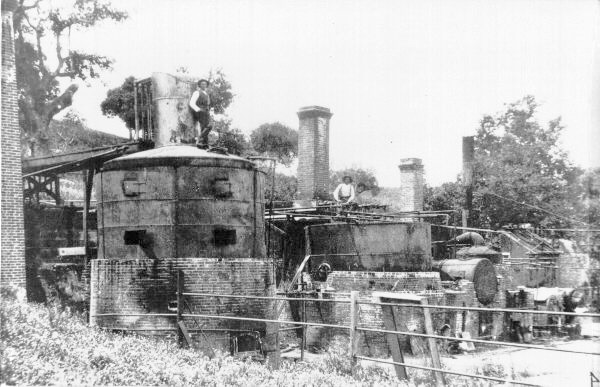
By 1880, California’s first commercial refinery processed oil from its first commercial oil well to make kerosene and other products. Photo courtesy the Santa Clarita Valley Historical Society.
Producing kerosene and lubricants, Newhall’s Pioneer Refinery on Pine Street would become the first successful commercial refinery in the West. Giant stills set on brick foundations included two capable of producing 150 barrels a day each. The city of Santa Clarita received California’s first successful refinery as a gift from Chevron in 1997.
The Santa Clarita refinery, today preserved as a tourist attraction, is among the oldest in the world. The major oil company can trace its beginnings to the 1876 Pico Canyon oil well, which has been designated a historic site by the California Office of Historic Preservation.
Chevron Corporation, once the Standard Oil Company of California, in 1900 acquired Pacific Coast Oil Company. Pacific Coast had become majority owner of California Star Oil Works in 1879.
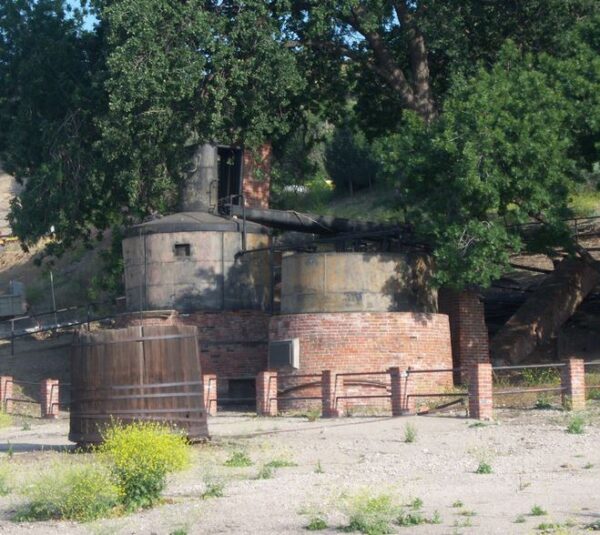
Santa Clarita acquired California’s first refinery as a gift from Chevron in 1997. It is one of the oldest existing oil refinery sites in the world. Photo by Konrad Summers.
Refining Kerosene for Lamps
California’s commercial refineries were among the first in America, where the industry began with small refineries in Pittsburgh, Pennsylvania, producing kerosene for lamps. The oil came from Titusville area oilfields — and a giant 1871 field discovered at Bradford, about 70 miles to the northeast.

The Bradford oilfield, which became known as America’s “first billion-dollar oilfield,” launched many Pennsylvania refineries, including the still-operating American Refining Group. The field’s first well produced just 10 barrels a day from 1,110 feet.
By 1875. Bradford leases reached as high as $1,000 per acre. A decade later, a sudden decline in the oilfield’s production led to a technological breakthrough. Pioneers in the new science of petroleum geology suggested that water pressure on oil sands could be used to increase oil production — “waterflooding” the geologic formation.
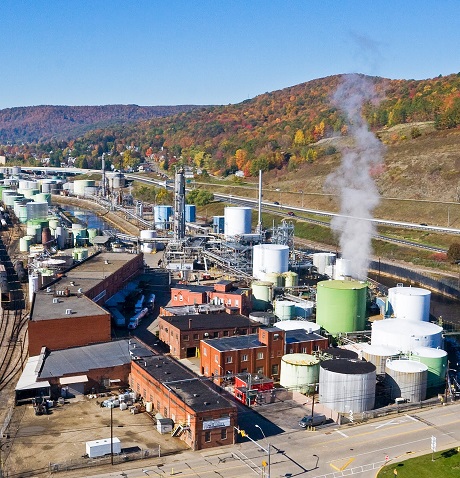
The oldest operating U.S. oil refinery began in 1881 in Bradford, Pennsylvania.
In Neodesha, Kansas, the Norman No. 1 well of 1892 revealed a petroleum-rich geologic region that would extend across Oklahoma, Texas, and Louisiana. Standard Oil built a refinery in Neodesha in 1897 that refined 500 barrels of oil a day. Standard was the first to process oil from the giant Mid-Continent field (learn more in Kansas Well reveals Mid-Continent).
In 2024, there were 134 operable petroleum refineries in the United States, according to the Energy Information Administration (EIA). The newest refinery with significant downstream capacity — a facility in Garyville, Louisiana — came online in 1977.
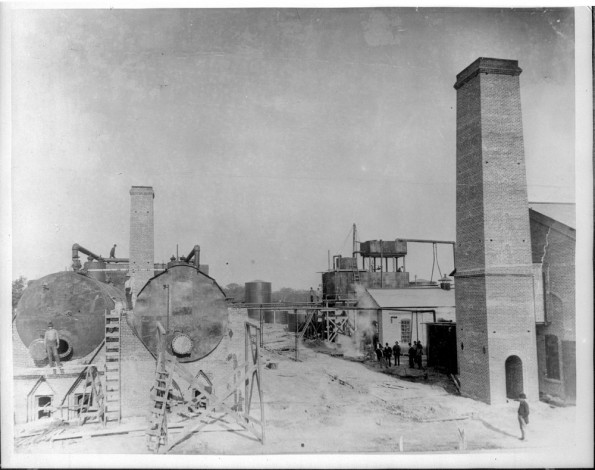
Built in 1897, a Standard Oil refinery in Neodesha, Kansas, refined 500 barrels of oil per day – the first to process oil from the Mid-Continent field. From “Kansas Memory” collection of the Kansas Historical Society.
For an investigation into which California oil well was the first, see this 2011 SearchReSearch blog of Dan Russell.
Learn more California petroleum history in the Signal Hill Oil Boom.
_______________________
Recommended Reading: California State University, Dominguez Hills (2010); Pico Canyon Chronicles: The Story of California’s Pioneer Oil Field
(2010); Pico Canyon Chronicles: The Story of California’s Pioneer Oil Field (1985). Your Amazon purchase benefits the American Oil & Gas Historical Society. As an Amazon Associate, AOGHS earns a commission from qualifying purchases.
(1985). Your Amazon purchase benefits the American Oil & Gas Historical Society. As an Amazon Associate, AOGHS earns a commission from qualifying purchases.
_______________________

_______________________
The American Oil & Gas Historical Society (AOGHS) preserves U.S. petroleum history. Please become an AOGHS annual supporter and help maintain this energy education website and expand historical research. For more information, contact bawells@aoghs.org. Copyright © 2025 Bruce A. Wells.
Citation Information: Article Title: “First California Oil Well.” Authors: B.A. Wells and K.L. Wells. Website Name: American Oil & Gas Historical Society. URL: https://aoghs.org/petroleum-pioneers/first-california-oil-well. Last Updated: September 17, 2025. Original Published Date: September 9, 2015.
by Bruce Wells | Jan 20, 2025 | This Week in Petroleum History
January 20, 1886 – Great Karg Well erupts Natural Gas in Ohio –
A well drilled for oil near Findlay, Ohio, erupted natural gas flowing at 12 million cubic feet per day from pressure that could not be controlled by technologies of the day. The “Great Karg Well” ignited into a flame that burned for four months and became a Findlay tourist attraction. Eight years earlier, a gas well in Pennsylvania had made similar headlines (see Natural Gas is King in Pittsburgh).
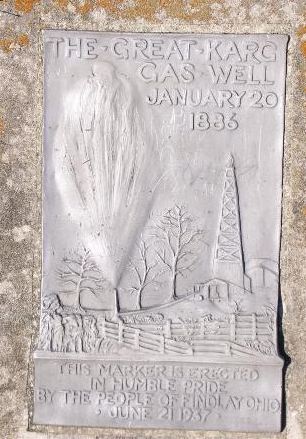
A plaque dedicated in 1937 at Findlay, Ohio, commemorated the state’s 1886 giant natural gas discovery.
Although Ohio’s first natural gas well was drilled in 1884 by the Findlay Natural Gas Company, the Karg well launched a gas-drilling boom that attracted manufacturing industries. Glass works companies were lured by the inexpensive gas (also see Indiana Natural Gas Boom), and new businesses included eight window glass factories, two bottle, two chimney lamp, one light bulb, one novelty, and five for tableware.
By 1887, Findlay was known as the “City of Light,” according to a historical marker erected in 1987 at the first field office of the Ohio Oil Company, which adopted the name Marathon Oil in 1962. The Hancock Historical Museum has preserved Great Karg Well history less than two miles from the well site.
January 21, 1865 – Testing the Roberts Torpedo
Civil War veteran Col. Edward A.L. Roberts (1829-1881) conducted his first experiment to increase oil production by using an explosive charge deep in the well. Roberts twice detonated eight pounds of black powder 465 feet deep in the bore of the “Ladies Well” on Watson’s Flats south of Titusville, Pennsylvania.
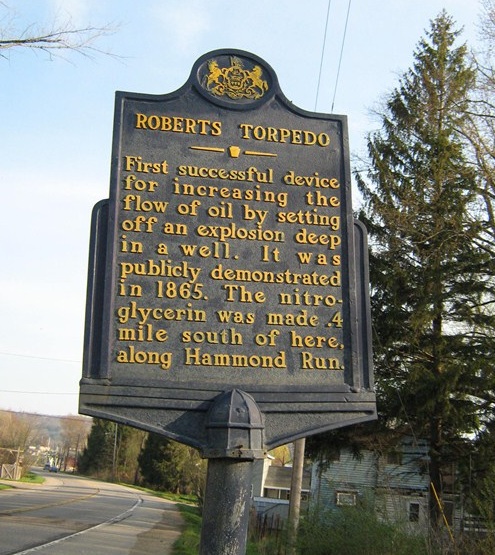
Civil War veteran Col. E.A.L. Roberts demonstrated his oil well “torpedo” south of Titusville, Pennsylvania.
The “shooting” of the well was a success, increasing daily production from a few barrels of oil to more than 40 barrels, according to Pennsylvania Heritage Magazine. By 1870, Roberts’ torpedoes using nitroglycerin became common in oilfields.
In April 1865, Roberts received the first of many patents for his “exploding torpedo,” and one year later the Titusville Morning Herald reported, “Our attention has been called to a series of experiments that have been made in the wells of various localities by Col. Roberts, with his newly patented torpedo. The results have in many cases been astonishing.”

January 22, 1861 – Pennsylvania Stills produce Kerosene
The first U.S. multiple-still oil refinery was brought on-stream one mile south of Titusville, Pennsylvania, by William Barnsdall, who had drilled the second successful well after Edwin Drake’s first U.S. oil discovery. Barnsdall and partners James Parker and W.H. Abbott spent about $15,000 to build six stills for refining kerosene. Equipment was purchased in Pittsburgh and shipped up the Allegheny River to Oil City where a refinery produced two grades of kerosene, white and the less expensive yellow.
January 22, 1910 – Standard Oil of California strikes Oil
Standard Oil Company of California (Socal) drilled its first successful oil well, a gusher in Kern County that initially produced 1,500 barrels of oil a day from the Midway-Sunset field. The discovery came after the 1906 merger of Pacific Coast Oil Company (see First California Oil Well) and Standard Oil Company of Iowa to create Socal.
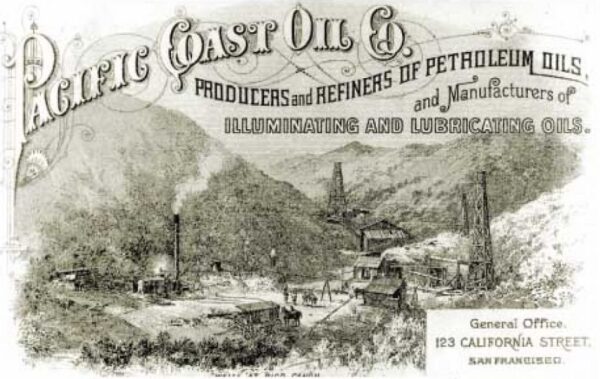
Standard Oil Company of California (Socal) began in 1879 as the Pacific Coast Oil Company and was renamed Chevron in 1981. Image courtesy Chevron.
The new company needed more oil reserves after it had “stepped up its marketing efforts, particularly in gasoline sales, which nearly doubled between 1906 and 1910,” according to a company history. “Until now, Standard had left the hunt for oil to others.”
The U.S. Supreme Court in 1911 ordered Socal separated from its parent, Standard Oil Company of New Jersey. After absorbing Standard Oil of Kansas in 1961 and making other acquisitions, the California company in 1984 rebranded as Chevron, headquartered in San Ramon.

January 23, 1895 – Standard Oil closes Oil Exchanges
Standard Oil Company of New Jersey’s purchasing agency in Oil City, Pennsylvania, notified independent oil producers it would only buy their oil at a price “as high as the markets of the world will justify” — and not “the price bid on the oil exchange for certificate oil.”
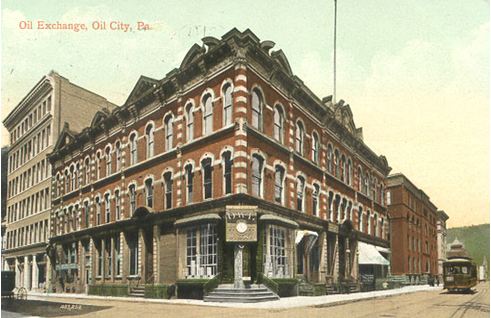
The Oil City, Pennsylvania, Oil Exchange was incorporated in 1874. Three years later, it was the third-largest U.S. financial exchange.
Oil City’s exchange had become the third largest financial exchange of any kind in America, behind New York and San Francisco. But with the Standard Oil Company buying 90 percent of oil production and setting its own price for certificates, all other oil exchanges soon closed.
Learn more in End of Oil Exchanges.
January 23, 1957 – Wham-O launches a New Petroleum Product
Among the earliest mass-produced products made from plastic, the “Frisbee” was introduced by Wham-O Manufacturing Company of California. The polymer toy originated in 1948 when a company called Partners in Plastic sold its “Flyin’ Saucers” for 25 cents each. In 1955, Richard Knerr and Arthur “Spud” Melin’s Wham-O bought the rights.
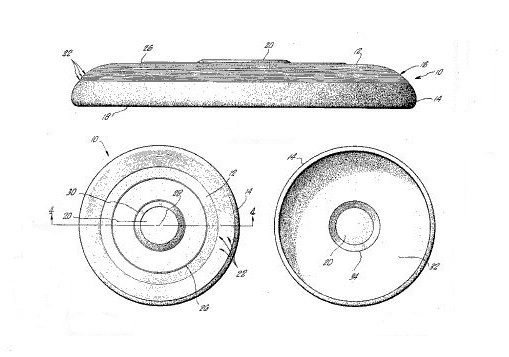
U.S. patent with mold details of a 1967 polyethylene plastic Frisbee.
The Wham-O founders discovered that Phillips Petroleum had invented a high-density polyethylene (called Marlex). They used the new plastic to meet phenomenal demand for manufacturing Frisbees – and Hula Hoops beginning in 1958.
Learn more in Petroleum Product Hoopla.
January 23, 1991 – Gulf War brings World’s Largest Oil Spill
The world’s largest oil spill began in the Persian Gulf when Saddam Hussein’s retreating Iraqi forces opened pipeline valves at oil terminals in Kuwait. About 11 million barrels of oil would cover an area extending 101 miles by 42 miles and reaching five inches thick in some places.
Iraqi soldiers sabotaged Kuwait’s main supertanker loading pier, dumping millions of gallons of oil into the Persian Gulf. By February, about 600 Kuwaiti wells had been set ablaze. It would take months to put out the well fires, with the last extinguished in early April (also see Oilfield Firefighting Technologies).

January 24, 1895 – Independent Producers found Pure Oil
To counter Standard Oil Company’s market dominance, Pennsylvania oil producers, refiners, and pipeline operators organized what would become a major Chicago-based oil venture. Originally based in Pittsburgh, Pure Oil Company quickly grew into the second vertically integrated U.S. petroleum company after Standard Oil.
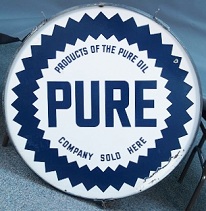
Ohio Cities Gas acquired Pure Oil in 1920 and kept the popular Pennsylvania brand name.
Beginning in early 1896, Pure Oil marketed its petroleum products by horse-drawn tank wagons in Philadelphia and New York — successfully competing with Standard Oil’s monopoly. The Ohio Cities Gas Company of Columbus acquired Pure Oil and in 1920 adopted the former Pennsylvania venture’s brand name.
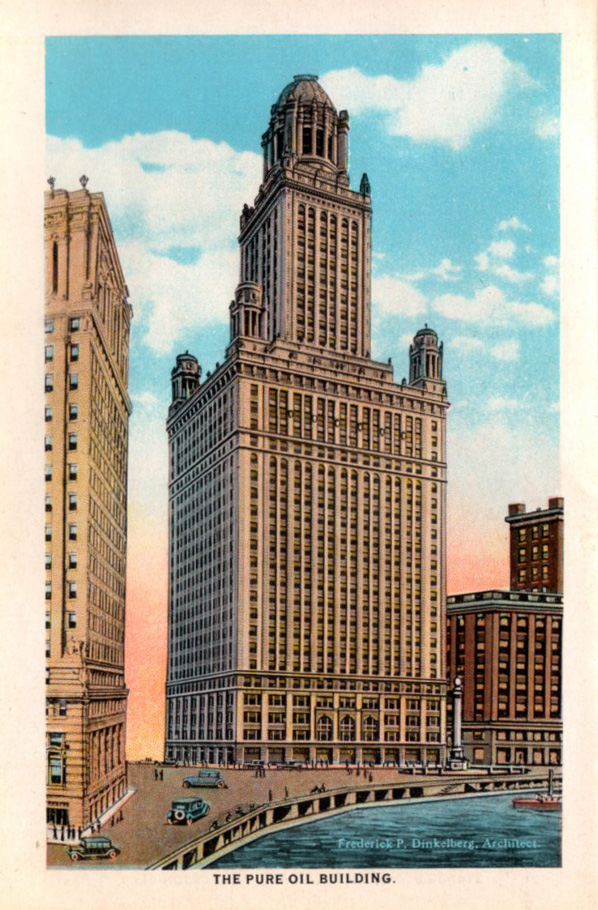
Pure Oil Company moved into its newly built 40-story Chicago headquarters on East Wacker Drive in 1926.
With a new Chicago headquarters opened in 1926, Pure Oil began exploring offshore technologies within a decade. The company developed early freestanding drilling platforms in the Gulf of Mexico.
January 25, 1930 – North Texas Oil Producers form Association
After meeting in Wichita Falls to protest “the recent drastic price cut in crude oil, inaugurated by some of the major purchasing companies,” 50 independent producers organized the North Texas Oil and Gas Association. Other issues included seeking a tariff on foreign oil imports and stopping “hot oil” oilfield thefts. The association merged with the West Central Texas Oil & Gas Association in 1998 to become the Texas Alliance of Energy Producers.

January 26, 1931 – Third Well reveals Extent of East Texas Oilfield
As East Texas farmers struggled to survive the Great Depression, an oil discovery confirmed the existence of a massive oilfield. W.A. “Monty” Moncrief of Fort Worth completed the Lathrop No. 1 well, which produced 7,680 barrels of oil a day from 3,587 feet deep. Geologists at first thought a third oilfield had been found.
Moncrief’s discovery well was 25 miles north of the famous Daisy Bradford No. 3 well of October 1930, drilled by Columbus Marion “Dad” Joiner. It was 15 miles north of the Lou Della Crim No. 1 well, completed at Kilgore three days after Christmas 1930. The 130,000-acre East Texas oilfield would become the largest in the lower 48 states.
Learn more in Moncrief makes East Texas History.
_______________________
Recommended Reading: Myth, Legend, Reality: Edwin Laurentine Drake and the Early Oil Industry (2009); Portrait in Oil: How Ohio Oil Company Grew to Become Marathon
(2009); Portrait in Oil: How Ohio Oil Company Grew to Become Marathon (1962); Ohio Oil and Gas, Images of America
(1962); Ohio Oil and Gas, Images of America (2008); Trek of the Oil Finders: A History of Exploration for Petroleum (1975). Titan: The Life of John D. Rockefeller, Sr.
(2008); Trek of the Oil Finders: A History of Exploration for Petroleum (1975). Titan: The Life of John D. Rockefeller, Sr. (2004); Plastic: The Making of a Synthetic Century
(2004); Plastic: The Making of a Synthetic Century (1996); Against the Fires of Hell: The Environmental Disaster of the Gulf War
(1996); Against the Fires of Hell: The Environmental Disaster of the Gulf War (1992); The Black Giant: A History of the East Texas Oil Field and Oil Industry Skulduggery & Trivia
(1992); The Black Giant: A History of the East Texas Oil Field and Oil Industry Skulduggery & Trivia (2003). Your Amazon purchase benefits the American Oil & Gas Historical Society. As an Amazon Associate, AOGHS earns a commission from qualifying purchases.
(2003). Your Amazon purchase benefits the American Oil & Gas Historical Society. As an Amazon Associate, AOGHS earns a commission from qualifying purchases.
_______________________
The American Oil & Gas Historical Society (AOGHS) preserves U.S. petroleum history. Become an AOGHS annual supporting member and help maintain this energy education website and expand historical research. For more information, contact bawells@aoghs.org. Copyright © 2025 Bruce A. Wells. All rights reserved.
by Bruce Wells | Jan 24, 2019 | Petroleum Companies
People seeking obscure financial information probably will not find riches here – see Not a Millionaire from Old Oil Stock. The American Oil & Gas Historical Society, which depends on your donations, doesn’t have resources for extensive research.
But as AOGHS looks into forum queries as part of its energy education mission, investigations have revealed interesting stories like Mrs. Dysart’s Uranium Well and Buffalo Bill’s Shoshone Oil Company; others have found questionable dealings during booms and “black gold” fever epidemics like Arctic Explorer turns Oil Promoter.
Visit the Stock Certificate Q & A Forum and view company updates regularly added to the A-to-Z listing at Is my Old Oil Stock worth Anything? AOGHS will continue to look into forum queries, including these “in progress.”
Fairchild Petroleum
One company named Fairchild Petroleum was incorporated in 1921 capitalized at $120,000 in Paintsville, Kentucky, a few miles from the town of Oil Springs (also known as Medina) and home to the Big Sandy Oil & Refining Company. Although there was substantial interest in Johnson County’s petroleum prospects, there is little trace of Fairchild Petroleum activity in Kentucky.
More information may be available from the Kentucky secretary of state business services. This notwithstanding, in 1922 a Fairchild Petroleum Company drilled the No. 1 Boggs well in Brazoria County, Texas, and also drilled in Liberty County, near Nome. The No. 1 Boggs reportedly produced oil from a depth of 4,550 feet. The Texas Railroad Commission maintains records that may provide further insights. (more…)






(2010); Pico Canyon Chronicles: The Story of California’s Pioneer Oil Field
(1985). Your Amazon purchase benefits the American Oil & Gas Historical Society. As an Amazon Associate, AOGHS earns a commission from qualifying purchases.












